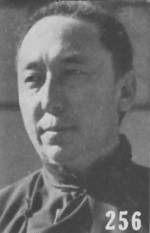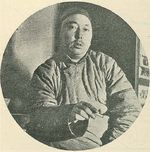Demchugdongrub
| Given Name | Demchugdongrub |
| Born | 8 Feb 1902 |
| Died | 23 May 1966 |
| Country | China |
| Category | Government |
| Gender | Male |
Contributor: C. Peter Chen
ww2dbaseDemchugdongrub was Mongolian of the Chahar tribe. His father, Namjil Wangchuk, was the Chief of the Shilingol League under Manchurian rule. His father passed away when he was six years old, and with the approval of the Qing Empire of China, he inherited of father's title of Duoluo Duling Junwang (a title equivalent to prince in the western world). After the fall of the Qing Empire in 1911, Han Chinese warlord Yuan Shikai gave him the title of Zhasake Heshuo Duling Qinwang in 1912. He had two wives, both daughters of noblemen, and had six children. In 1929, he was appointed by the Republic of China as a member of the Chahar Provincial Committee. In 1931, he became the Chief of Shilingol League, a position his father once held. In Sep 1933, Mongolian leaders gathered in attempt to find a man to lead all of the Mongol tribes, but traditional suspicions between tribes prevented success. In Oct, Demchugdongrub slowly took leadership of the group, and proposed to the Chinese government that the Mongolians of the Inner Mongolia region to govern themselves autonomously; if refused, he threatened to seek aid from the Japanese. By 1935, Demchugdongrub was clearly the leader of Mongolians in the region. He established the Inner Mongolian (Mengjiang) Autonomous Government in early 1935 with aid from the Japanese Army, but he and the Japanese Army representatives did not always agree. In May, an alliance was formed with Manchukuo, a Japanese puppet state in the Manchuria region of China; Kangde Emperor of Manchukuo granted Demchugdongrub the honorary title Wude Qinwang. In Aug 1935, he promised closer cooperation with Japan, and Japan promised financial aid. On 24 Dec, he was provided two battalions of irregular Manchurian cavalry, a squadron of Japanese aircraft, and a number of Japanese tanks by the Japanese to help him take six Chinese-held counties in the northern Chahar Province; the operation was successful. In Feb 1936, the autonomous government was reformed into the Mongolian Military Government with heavy Japanese influence; the government was officially formed on 12 May 1936 with aims to expand borders over all of Mongolia. In Jul 1936, the new Mongolian Military Government signed a mutual assistance agreement with Manchukuo and Japan. In 1939, the government was reorganized again into the Mengjiang United Autonomous Government, and Demchugdongrub was initially its Vice Chairman, and then the Chairman. In 1941, he assumed the title of the Chairman of the Mongolian Autonomous Federation. After Japan's surrender in 1945, his government fell, and Demchugdongrub moved to Beijing, China under the supervision of the Nationalist Party of China. As the communists began to gain the upper hand during the Chinese Civil War, he took the chance to establish an autonomous government once again in Aug 1949. After the communist victory over the Nationalists, the communists began a campaign toward Inner Mongolia, and his government quickly fell. He fled to the People's Republic of Mongolia and was arrested. In Sep 1950, he was deported to communist China and was found guilty of treason. He remained imprisoned until Apr 1963 before he was pardoned. He worked in a museum dedicated to Mongolians in Hohhot, China until his passing in 1966. He left a mixed legacy as someone who worked hard to unite all the Mongolian tribes, but at the same time collaborated with Japanese occupation forces.
ww2dbaseSource: Wikipedia.
Last Major Revision: Oct 2009
Photographs
 |  |
Demchugdongrub Timeline
| 8 Feb 1902 | Demchugdongrub was born in Sonid Right Banner, Chahar Province, Qing Dynasty China. |
| 8 Dec 1937 | Japan established the puppet nation of Mengjiang in the Inner Mongolia region of China. Its capital was at Kalgan (now Zhangjiakou), Chahar Province, China. |
| 11 Aug 1945 | Soviet and Mongolian troops captured Prince Demchugdongrub's palace and his family members at Sonid Right Banner, Chahar Province, China, but he was at Kalgan (Zhangyuan, later Zhangjiakou), Chahar Province. Demchugdongrub's family would be taken to Ulaanbaatar, Mongolia Area, China and treated with respect. |
| 19 Aug 1945 | Demchugdongrub and his followers departed Kalgan, Chahar Province (now Zhangjiakou), China for Beijing, China as Soviet-backed Outer Mongolian troops neared the city from the north and communist Chinese troops approached from the south, thus effectively ending the Japanese puppet state of Mengjiang. |
| 18 Sep 1950 | Demchugdongrub was deported from Mongolia to communist China to face imprisonment. His eldest son was executed, and the rest of his family was exiled to the countryside without any means of supporting themselves. |
| 23 May 1966 | Demchugdongrub passed away in Hohhot, Inner Mongolia, China. |
Please consider supporting us on Patreon. Even $1 per month will go a long way! Thank you. Please help us spread the word: Stay updated with WW2DB: |
Visitor Submitted Comments
All visitor submitted comments are opinions of those making the submissions and do not reflect views of WW2DB.

- » Wreck of Teruzuki Found (27 Jul 2025)
- » USS Orlean's Bow Found (22 Jul 2025)
- » The Emperor of Japan Planned to Honor WW2-era Japanese POWs in Mongolia (4 Jul 2025)
- » US State Lawmaker John Winter Caught Using Racial Slur "Jap" and Apologized (11 Jun 2025)
- » US Government Plans to Purge WW2 Information (17 Mar 2025)
- » See all news
- » 1,182 biographies
- » 337 events
- » 45,115 timeline entries
- » 1,248 ships
- » 350 aircraft models
- » 207 vehicle models
- » 376 weapon models
- » 123 historical documents
- » 261 facilities
- » 470 book reviews
- » 28,413 photos
- » 365 maps
Lt. Gen. Lewis B. "Chesty" Puller, at Guadalcanal
26 Jun 2010 06:31:05 PM
Thanks for the info. of Mr. Demchugdongrub, Mongolian, and the Chahar tribe.
I've studied a lot about the Manchukuo, but with very little info. about what's the factors of the separation of Inner Mongolian and Mongo Rep.